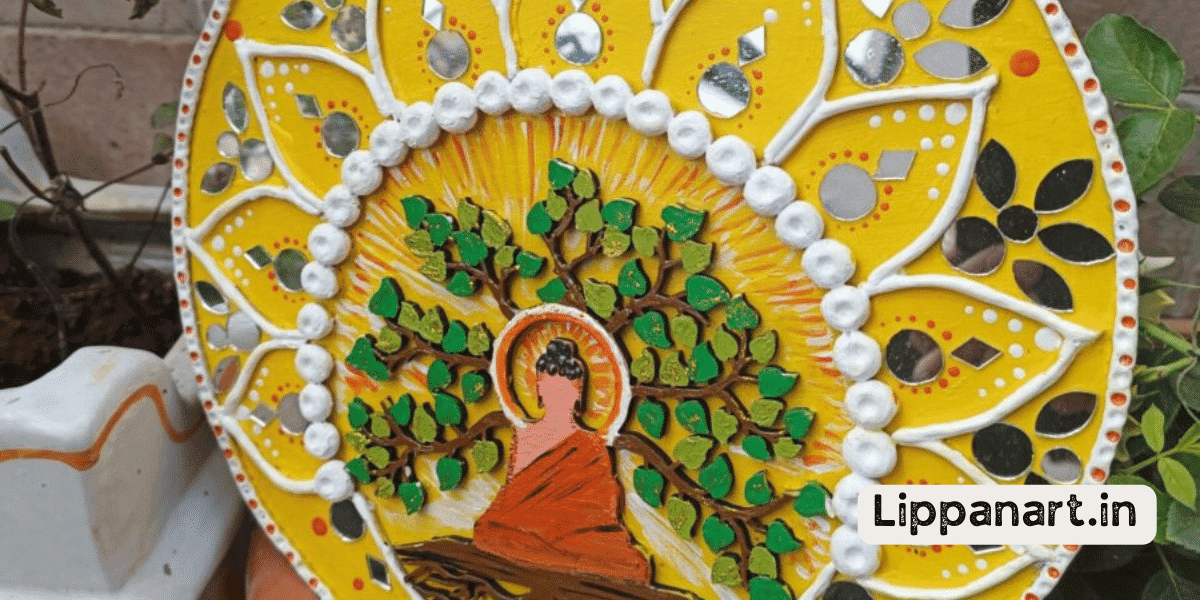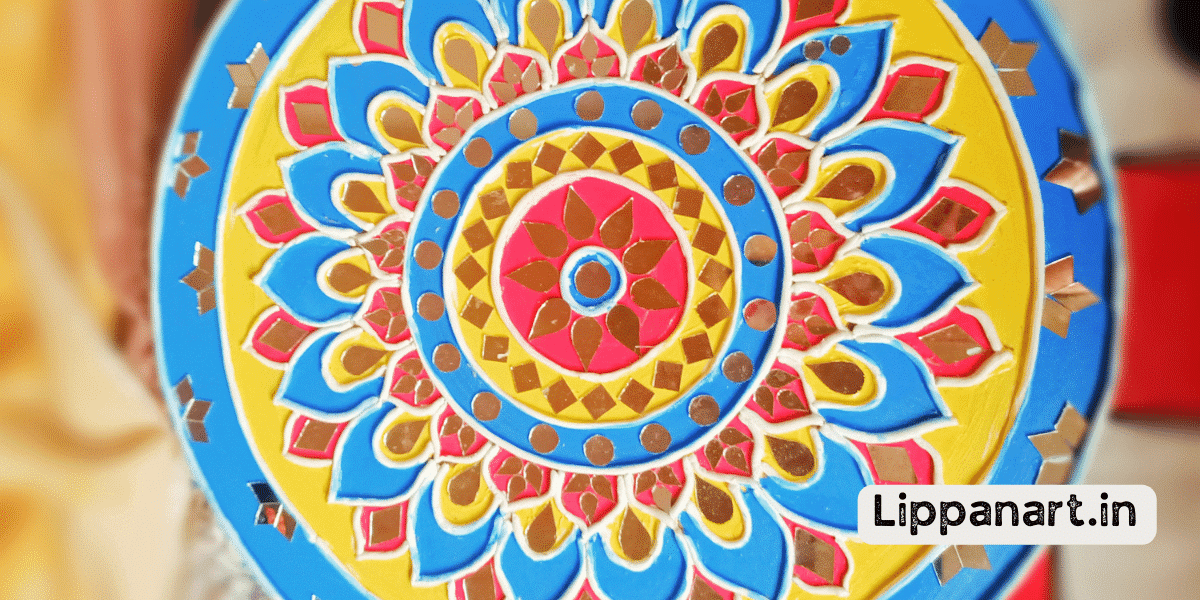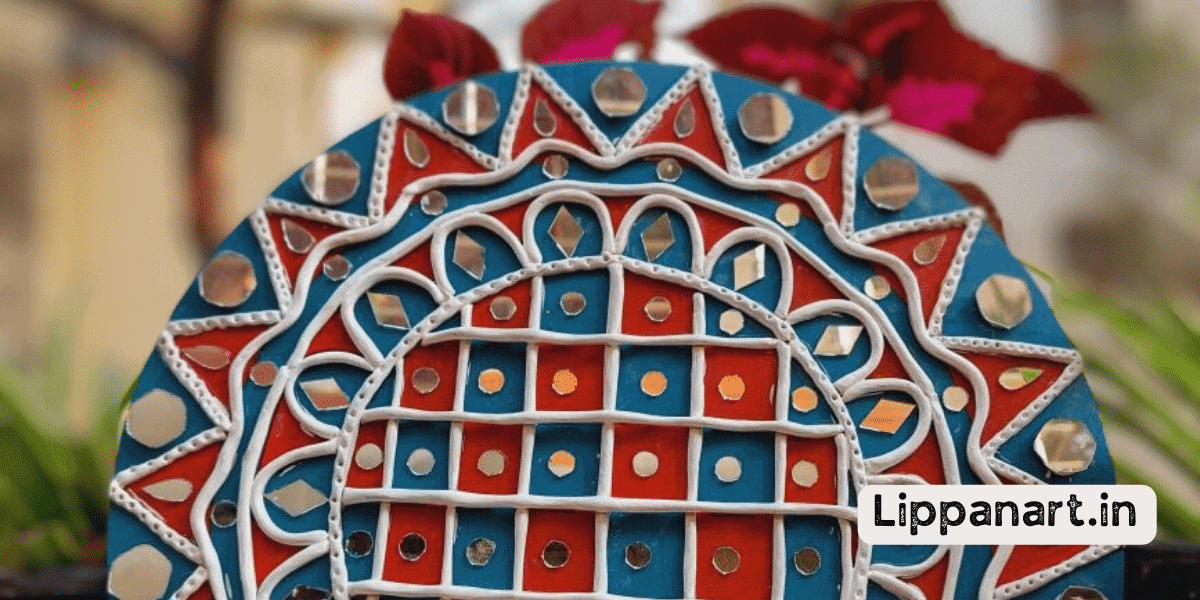Are you prepared to tap into your creative side?
Lippan art is the perfect way to do that, and clay powder is the key ingredient to bring your creativity to life.
This ancient art form is an explosion of colour, texture, and pattern that will transform any space into a vibrant, eye-catching masterpiece.
This article will provide the tools you need to confidently explore your creativity, from preparing and applying the clay powder to designing and finishing your lippan art.
Introduction to Lippan Art and Clay Powder
Lippan art is a traditional art form native to the Kutch region of Gujarat, India. It combines the words ‘Lippan’ and ‘Kam’, meaning mud art. Clay powder is an integral part of this art form. It is the main material used to create intricate designs and patterns. Clay powder provides structure and texture to the art. It is the basis of all Lippan art.
Importance of clay powder in Lippan Art
Using clay powder, you can create intricate and beautiful designs that can be admired for years. Clay powder is the key ingredient in the traditional Indian art form of Lippan Kaam. It allows you to create vivid murals and wall hangings that bring life and colour to your home.
Ceramic clay powder is the best choice for this art form. It is easy to work with and can be moulded to create stunning shapes. One of the advantages of using clay powder for Lippan art is its durability. This ensures that the artwork can withstand the test of time and remain intact for a long period. Its versatility also allows you to create any design you can imagine.
Preparing Clay Powder for Lippan Art
If you want to create lippan art, the first step is to prepare the clay powder. Choosing the right type of clay powder is important; you’ll need to decide if you want to use natural or synthetic clay.
After that, you must mix the clay powder to the desired consistency. Using your hands or a mortar and pestle are effective ways to mix the clay powder.
Choosing a suitable clay powder type
Choosing the right clay powder is essential to creating successful lippan art. Different types of clay can be used to create a variety of effects. Consider these clay powder types:
- Cow dung mixed with shikar clay to create a textured finish.
- MDF board or air-dry clay for creating intricate details.
- Clay for art and craft for a smooth and durable finish.
No matter the desired effect, the right clay powder can bring the artwork to life. Experiment with the various types of clay to create unique and innovative designs. With the right materials, anyone can create beautiful and intricate pieces of lippan art.
Mixing clay powder for desired consistency
Getting the right consistency for the clay powder is essential for creating successful lippan art.
One can achieve the ideal texture by blending clay powder with white acrylic paint and clay acrylic paint for art material.
The ratio of clay powder to paint should be adjusted depending on the type of solobolo lippan art wall you are creating.
Ensure that the mixture is thick enough, as this could affect your motor skills when you are applying the mixture.
For a thicker texture, add more clay powder; for a thinner texture, add more paint.
Ultimately, it’s all about getting the perfect ratio of clay powder to paint for your lippan art.
Applying Clay Powder on Surfaces
Before starting your Lippan art project, you must prime the surface first.
To ensure an even and consistent application, use a brush to apply the clay powder across the surface.
From there, you can create a variety of textures and patterns to bring your design to life.
Priming the surface for Lippan Art
Before applying lippan art, it’s important to prime the surface. This can be done by mixing clay powder with a binding agent. Doing this will create a strong foundation for the lippan art design. This will ensure that the design lasts for a long time. You will need a few items from your lippan art kit to prime the surface. These include a cone to mix the clay powder and binding agent, a brush to apply the mixture to the surface, and a cup to hold the mixture.
Village ladies have used this technique for centuries to craft beautiful lippan art. Their designs have stood the test of time. Following this simple priming process, you can create beautiful lippan art designs that will last for ages.
Even application techniques
Once your surface is primed, you’ll want to apply the clay mixture evenly to create a solid foundation for your lippan art design. To do this, you can use modelling clays or mix clay powder with a base like glue or paint to create a malleable texture.
Then, spread the mixture on the board or canvas in a thin, even layer. To ensure even coverage, you can use a brush, roller, or spatula to spread the clay. Once the clay is spread, let it dry and add texture to your paintings.
Remember to use the right technique to get the desired results!
- Editor’s Choice
- Best Seller
- Amazon Choice
Creating textures and patterns
After the clay has dried, feel free to add texture and patterns to your lippan art by pressing various objects or tools into the surface. Get creative and explore the possibilities!
Here are some ideas to help you get started:
- Experiment with different art projects that involve clay powder to create unique textures and patterns
- Use everyday objects like coins, keys, or even feathers to make impressions on the clay
- Try using a brush or sponge to create various shapes and designs with the clay powder, and make your lippan art truly one-of-a-kind!
With these techniques, you can make your lippan art projects truly unique and innovative.
Designing with Clay Powder in Lippan Art
Designing with clay powder in lippan art is an exciting and creative endeavour! You can explore different design ideas, craft intricate patterns and motifs, and add depth and dimension to your work.
It takes imagination and practice to master this art form and create stunning pieces.
Exploring design ideas
You’ll want to explore different design ideas when creating lippan art with clay powder. This art form is a great way to unleash your creativity and discover new methods of expression.
Consider the following when looking for design ideas:
- Utilize acrylic paint to add colour to your work
- Try different shapes and patterns to create unique textures
- Incorporate clay powder into your design to add depth and complexity to the piece
Embrace the power of clay powder and acrylic paint to create something remarkable. Experiment freely with these materials and let your imagination take control.
Crafting intricate patterns and motifs
Experiment with intricate patterns and motifs to add a unique flair to your artwork. Fevicryl moulds are an ideal way to get creative with clay powder and create something unique.
You can let your imagination go wild, from clay jewellery to moulded clay figures. Use clay moulds to craft intricate designs, or mix and match different patterns and motifs to create something truly special.
With clay powder, the possibilities are endless. With a little practice, you can make beautiful clay art that will stand out from the rest.
Adding depth and dimension
To add depth and dimension to your clay art, try lippan work. You can create stunning three-dimensional pieces with ceramic powder, clay mixture, ropes, strips, and air-dry clay. Experiment with various techniques to create texture and shape.
Here are a few tips to get you started:
- Use clay strips to create structures and details.
- Experiment with clay ropes to create intricate patterns and motifs.
- Let your imagination run wild by combining different clay mixtures.
Push your creativity to the limit and explore the various possibilities of lippan art. Don’t be afraid to try something new. Using these tools and techniques you can craft an exceptional work of art.
Finishing and Maintaining Lippan Art
Once you have finished designing your lippan art piece using clay powder, it’s important to ensure it’s properly dried and hardened. To do this, you can use a fan or heat source to speed up the drying process.
Once the piece has hardened, you can apply your final touches, such as paint or varnish. This will help protect your artwork and make it last longer.
- Editor’s Choice
- Best Seller
- Amazon Choice
Proper drying and hardening of clay powder
After you’ve applied the clay powder, it’s important to let it dry and harden properly. For air-dry clay art and craft, you can use Jovi air-dry modelling clay as it’s easy to shape and use. Ensure you don’t use wet clay, which won’t give you the desired colourful pieces. If you use ceramic clay, it should be put in a kiln to ensure it completely hardens.
Tips to properly dry and harden clay powder:
- Keep clay away from moisture
- Allow the clay to air dry for several days
- Fire the clay in a kiln for ceramic clay pieces
Applying final touches (paint, varnish)
Once your clay pieces have dried and hardened, you can finish them with paint and varnish to complete your project. The tools and materials you’ll need include a paper plate, a plastic cone, white paint, moulded clay, and a clay peacock. You’ll need to use the right technique to get the best results.
| Technique | Result |
|---|---|
| Use a paper plate and a plastic cone to mix the paint and varnish | Achieves a uniform colour and texture |
| Add white paint to the Mouldit clay | It gives the clay an opaque, vibrant look |
| Apply the paint and varnish to the clay peacock | Enhances the visual appeal of the piece |
Maintaining and preserving your artwork
Now that you have created your amazing lippan art using Shilpkar clay, it is important to know how to maintain and preserve it. To make your artwork last, it is essential to follow these steps:
- Seal the artwork with a coat of Fevicryl.
- Use a lippan art painting brush and acrylic colour set to refresh fading colours.
- Place the artwork in a cool, dry environment to protect it from dirt, dust, and other environmental factors.
Following these simple steps, your lippan art frog, coils, and other creations will remain intact and vibrant for years.
You can create a beautiful, lasting piece of art using the right materials and tools, such as shikar clay, lippan art painting brushes, and an acrylic colour set.
Frequently Asked Questions
What Other Materials Can Be Used in Lippan Art?
Like a kaleidoscope of colours, lippan art can be created with various materials, from fabric to paper, wood to metal. Get creative and explore new options to make your artwork stand out. Try experimenting with unusual textures or bold shapes to make a unique piece that truly shines.
How Can I Store and Preserve Clay Powder for Future Use?
Store clay powder in an airtight container to preserve it for future use. Use moisture-resistant materials and cool, dry places to keep it in optimum condition.
Can I Use Different Colors of Clay Powder to Create a Multi-Colored Design?
Yes, you certainly can! Mixing different colours of clay powder is a great way to create a unique, multi-coloured design. Don’t worry if you’re new to lippan art – you’ll quickly get the hang of it. Experiment with different colours and watch your artwork come to life!
What Is the Best Way to Remove Clay Powder From Surfaces?
The best way to remove clay powder is with a damp cloth. Make sure to use gentle movements and don’t scrub, as this could damage the surface. Be creative and innovative to ensure a successful clean.
Is It Possible to Make a 3D Design With Clay Powder?
Yes, absolutely! Using your imagination and creativity, creating incredible 3D designs using clay powder is possible. Just use an anachronism to get inspired, and then let your imagination take over! You can create stunning 3D designs with simple tools and techniques that will wow your friends and family.
Conclusion
You’ve now learned how to use clay powder for lippan art!
From preparing the clay powder to applying it on surfaces, you can create beautiful designs that will last. And with proper finishing and maintenance of your lippan art, you can keep your design sparkling like a diamond in the sky. So what are you waiting for? Grab some clay powder and get to creating your masterpiece!














